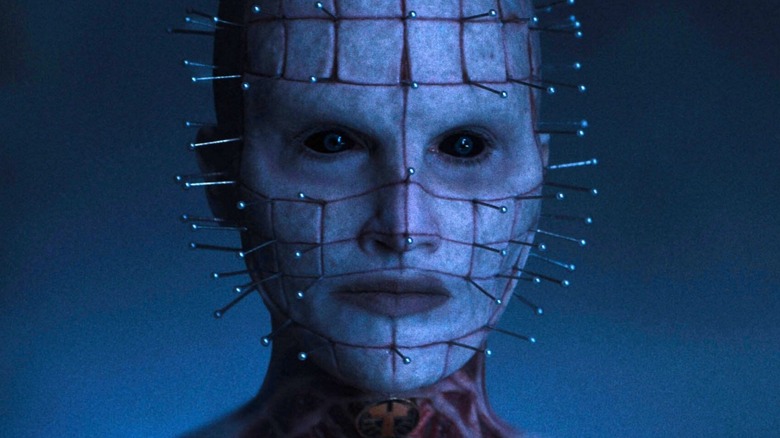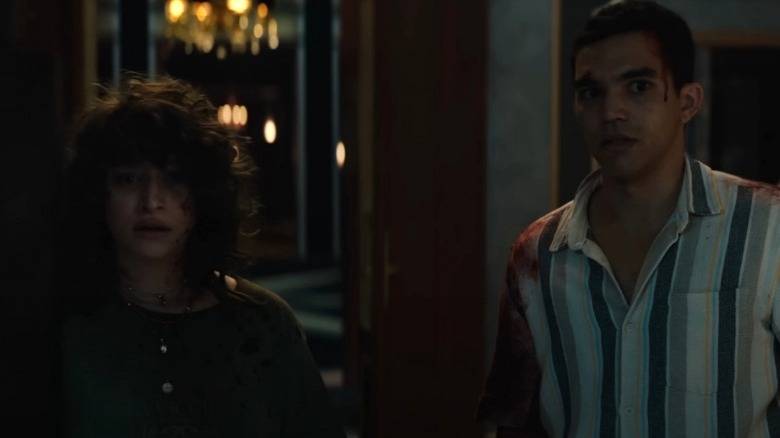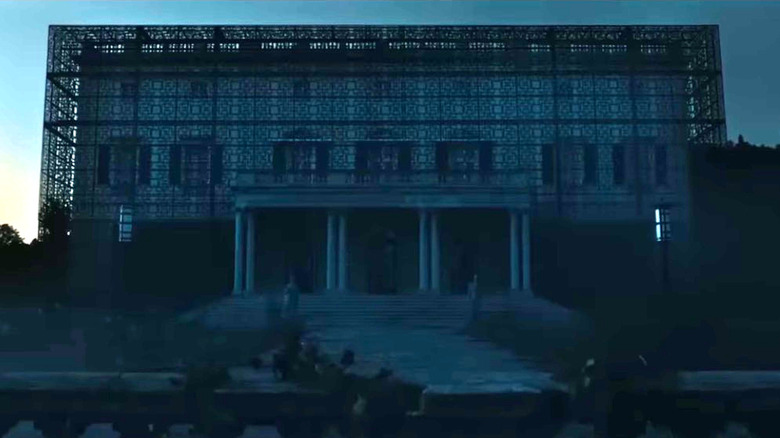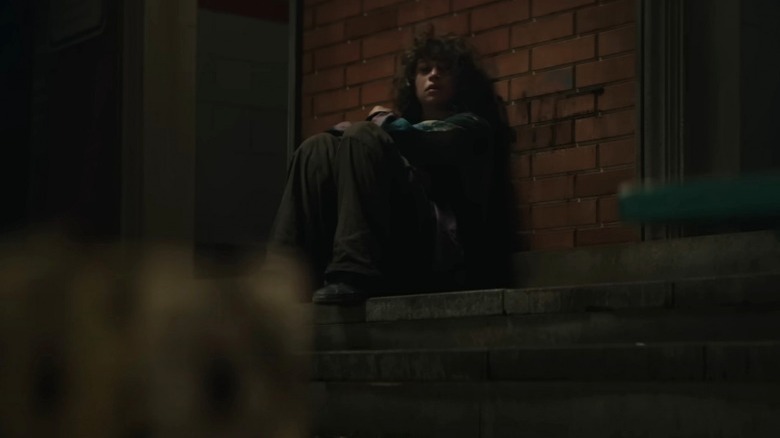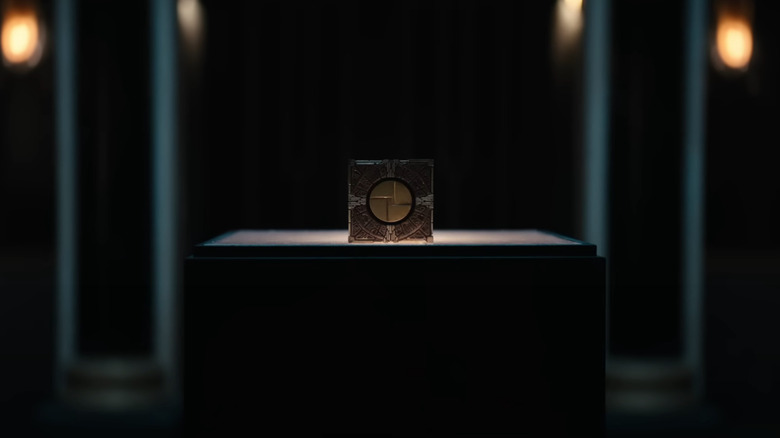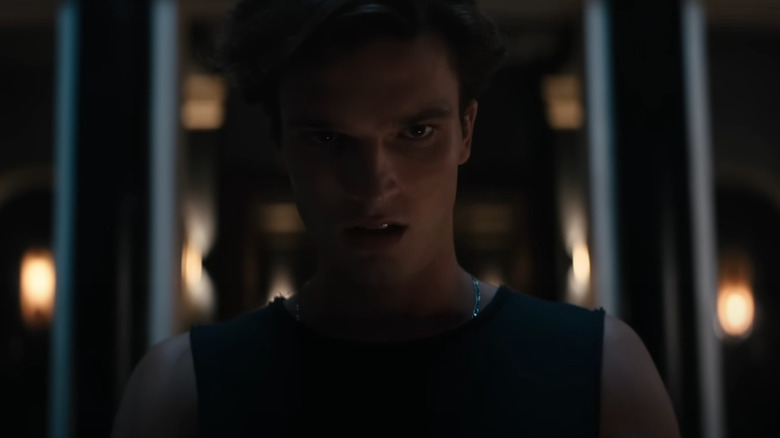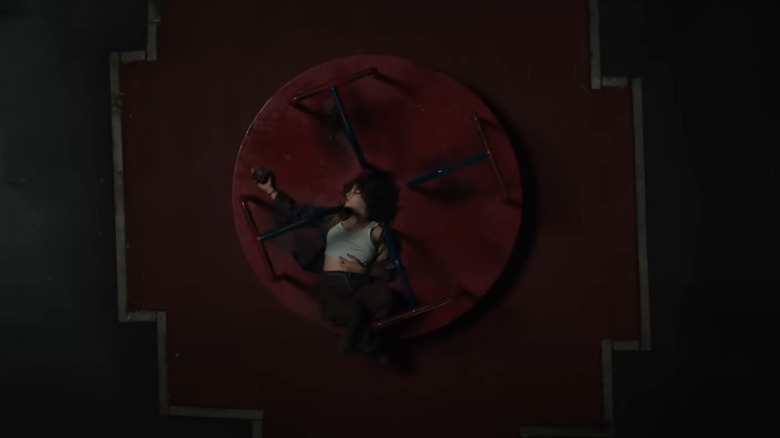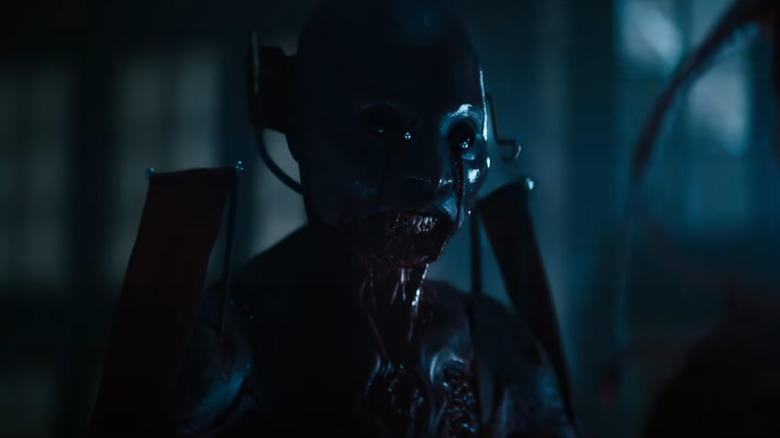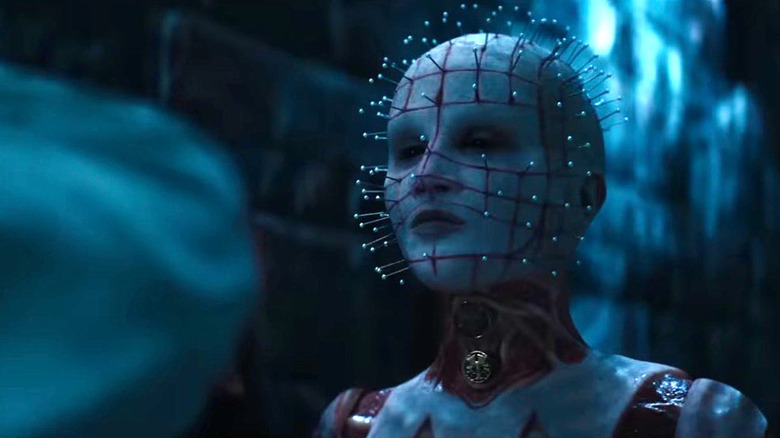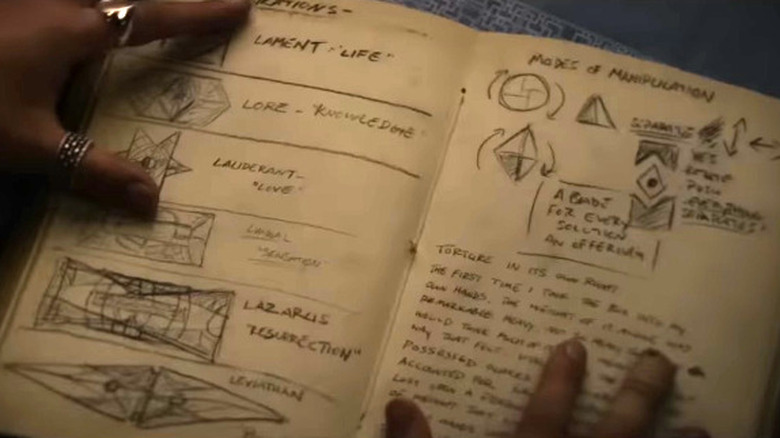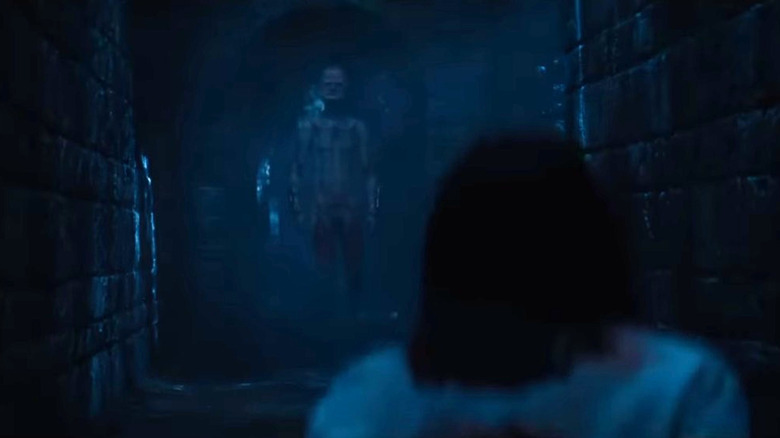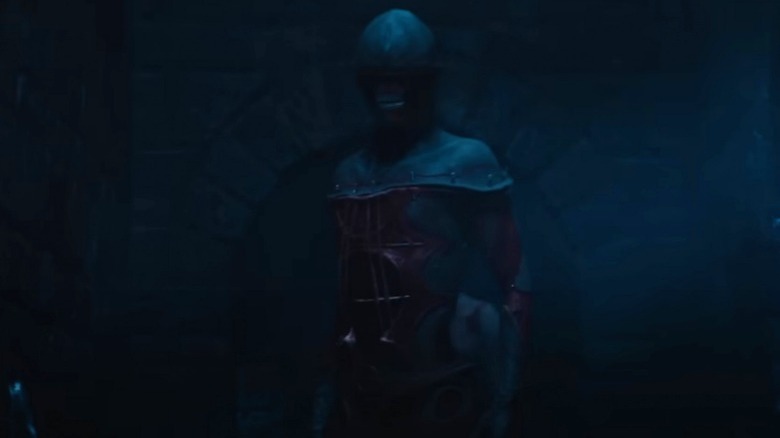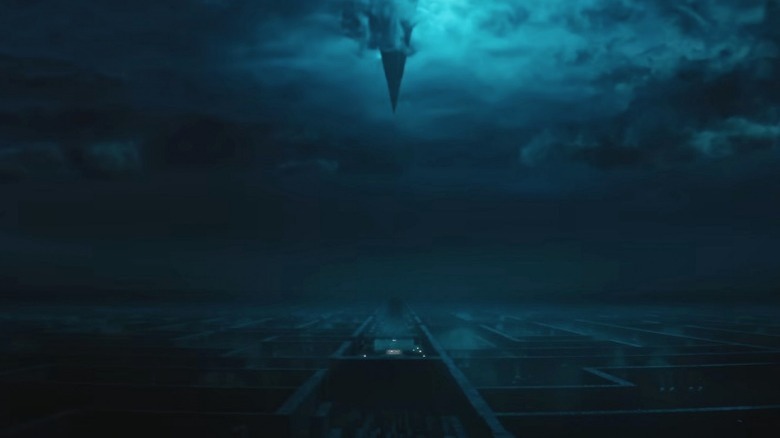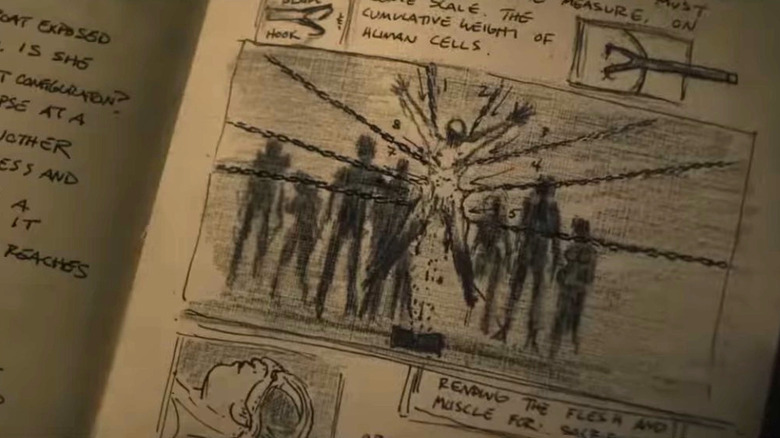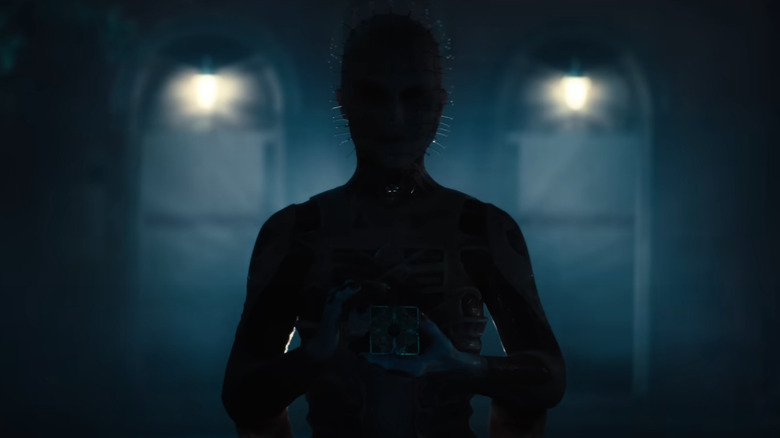The 7 Best And 7 Worst Things About Hulu's Hellraiser
In 1987, visionary writer-director Clive Barker adapted his novella "The Hellbound Heart" into his first feature film: "Hellraiser." Even if 1987 viewers were familiar with the source material, it's highly unlikely that they were fully prepared for the gorgeous, dark, and perverse nightmare they were walking into. The film played with themes of ultimate pleasure and pain and just how far people will go in pursuit of their darkest desires.
The unique horror film gave way to a notoriously terrible avalanche of "Hellraiser" movies, the franchise spawning nine more in-continuity films in just over three decades. Although some of them have moments, designs, and ideas that work, the vast majority of them are absolute nonsense. Therefore, it makes sense that the series would finally start from scratch to rebuild a more cohesive universe. Thus, a brand new film titled "Hellraiser" was released on Hulu.
Directed by David Bruckner ("The Night House"), the reboot ignores all the films that came before to tell a new story as the foundation of a franchise that promises to be far truer to the intent of the original film and the novella it was based on. While this reboot is undoubtedly the best "Hellraiser" film in years, no movie is perfect, and we intend to explore everything about it that works as well as the things that don't quite measure up.
Worst: The characters
While the cliche of horror characters being dull and uninteresting has typically been linked with slasher movies, the other subgenres are not immune to this — especially the "Hellraiser" sequels. What's frustrating about the new film is that it gets so close to succeeding where so many others have failed.
The protagonist is Riley (Odessa A'zion), a recovering addict with a crummy job, a protective brother named Matt (Brandon Flynn), and a (sort of) boyfriend named Trevor (Drew Starkey), who is definitely a bad influence. They feel like real people with real problems and flaws that they're working on, which is a breath of fresh air for this franchise. Just as we're getting to know them, however, the movie gets so bogged down in plot that they don't really get a chance to develop.
It's great that Riley wants to figure out what's going on because she feels guilty over her brother's disappearance and it's almost interesting that Trevor is a secret villain, but these character traits are played as plot devices rather than shades of their personality. If the film had eased back on building the world and mythology and given the characters a chance to breathe — as David Bruckner does in his other horror films, "The Ritual" and "The Night House" — the characterizations would have been a strength rather than a missed opportunity.
Best: That house
About half of the running time for "Hellraiser" is set in the mansion of the mysterious Roland Voight (Goran Višnjić). It's a huge concrete building surrounded by metal, like a cage (which it actually is). Inside, the walls move and more gates and cages spring out of nowhere. The design appears to be part of an overall puzzle motif. As Trevor says when he and Riley break into a safe to find a wooden box with another box inside, this film is all about "boxes within boxes."
Or should that be, puzzles within puzzles, since all the metal surrounding the house operates similarly to the configurations of the mysterious puzzle box at the center of the film? Voight designed it after feeling like the Cenobites tricked him into spending his life in torture as a means of trapping them in order to make any demands he wanted. That part of things actually leans into one of the problems with the film's narrative — but the inventiveness of the visual alone is worth celebrating, as well as how evocative the design is of the film's core themes.
Worst: The plot
The plot of the 2022 "Hellraiser" makes perfect sense on its own terms: A recovering addict is conned into retrieving a supernatural puzzle box by a man she thinks she can trust, only to discover that her actions have brought forth terrifying beings from another dimension intent on conducting sensual experiments on human beings. Sounds wild, but it works as a "Hellraiser" plot because it's all about internal suffering, weakness, and regret.
Had that been the entire focus of the film, then the plot would be listed here as one of the best things about the movie. Unfortunately, the obsession with puzzles spills over into its convoluted plot as well. We're hit with a lot of backstory, mythology, and exposition as well as a third act with so many plot twists, it'll make your head spin. At least the film isn't asking us to be caught up on 31 years of "Hellraiser" franchise history, too.
Riley's personal arc in this film is put on the back burner for a while so we can find out that Trevor's been playing her the whole time, that Voight is still alive and has concocted this plan to trap and manipulate the Cenobites to end his suffering — all while the other characters are learning the rules of how the box works and trying to navigate the house. It's just a lot to take in.
Best: The look
Sometimes, even if a "Hellraiser" movie is bad, the visuals are still engaging. Nothing beats the first time you see the light shining through cracks in the walls and the horrific Cenobites awash with brightness staring straight down the lens of the camera, but there are occasional moments of inventiveness sprinkled throughout the franchise. The reboot has them all (except the first film) beat.
This is a slick, polished-looking movie that oscillates between real-world mundanity and a waking nightmare. Again, the design of the house is incredible and the entire movie could have easily taken place there, but the rest of the locations are great as well. Whether it's the park where the Cenobites make their debut, Trevor's moody loft apartment, or the gothic hallways made of shadow and stone, there isn't a single set that fails to hold your attention. Thanks to Eli Born's stellar cinematography, the seamless CGI, and art design, this is a fully realized world that would be worth revisiting in future installments.
Worst: The opening
If you've never seen a "Hellraiser" film before, then the opening of the reboot is the perfect entry point. It hints at the events to come while keeping everything else shrouded in mystery. A woman named Serena (Hiam Abbass) purchases the iconic box and exchanges some words about the mysterious antagonist of the film Voight. We then cut to that great house where an indulgent party is taking place and Serena tells a young man named Joey (Kit Clarke) where he can find Voight.
Joey is tricked into solving one of the box's configurations and is raised into the air by chains while Voight prays to the Leviathan. It's an enticing glimpse of things to come that eases the audience into the world of the film effectively. So there's nothing wrong with it narratively. The problem is that if you're familiar with "Hellraiser," then you know exactly what's going to happen.
The first film throws the audience into the darkest corners of the deep end with an opening that sees Frank (the film's villain, played by Sean Chapman) buying the box, opening it, and being torn apart. We then see Pinhead sorting through chunks of Frank's face on the floor before closing the box and disappearing. It's a shock to the system that provides zero context and shows you just how twisted and terrifying the film will be. The new film's opening by comparison is pretty tame and predictable.
Best: The music
In a decade when the most memorable movie scores were earworms that got stuck in your head like a commercial jingle (think of the themes from "Halloween," "Friday the 13th," or "1, 2 Freddy's coming for you"), the original score for "Hellraiser" stood out for being beautiful and ominous at once, like something out of a dark opera. You don't go around with it looping in your head to an annoying degree, you feel it in your bones — a lullaby from the shadows.
The score helped to play into the themes of pain and pleasure being indivisible, of heaven and hell existing solely in the eye of the beholder, and of a deeper menace lingering in the human heart. As film scores have leaned more toward simply coloring the scene rather than being of a piece in recent years, it is so good to hear Ben Lovett's new "Hellraiser" score calling back to Christopher Young's original. It links the new film to the original in a way that reminds you that this is indeed a "Hellraiser" film but stands apart enough to be its own "Hellraiser" film.
Worst: The prosthetics
Make no mistake: The designs of the Cenobites are fantastic. In the original film, they were pale, striking creatures with elements of torture all over their mangled forms. As the series went on, they devolved into increasingly watered-down and cheaper versions of the original designs. In the remake, they are walking, talking works of art that invite the viewer to examine all the ways they've abused and reformed themselves.
One Cenobite in particular (credited on IMDb as The Asphyx) is one of the creepiest things not only in "Hellraiser" but in horror — period. It's an individual whose skin has been permanently wrapped around their face so they are in a constant state of suffocation. They shamble through dark halls, blind and wheezing to truly unsettling effect. The updates on the classic Cenobites are great, too.
The only problem is the physical prosthetics. While the artists who constructed them probably worked tirelessly to make them look as realistic as possible, there is something plastic and rubbery about them that distracts from the reality the film is attempting to create. Unfortunately, as cool as the designs are, they often look like actors in suits — sort of like horrific, adult versions of "Power Rangers" villains.
Best: Pinhead
Well, okay, the character isn't called Pinhead technically, but that's who they are. Just like with the original film, the poster child for the franchise was given a title rather than a name. Doug Bradley's debut as the character was simply referred to as "Lead Cenobite," while Jamie Clayton is referred to as "the Priest." For all intents and purposes though, the character is Pinhead and we will continue to refer to them as such.
Recasting an iconic character is tricky, especially when one actor (Doug Bradley) has been associated with them for so long. It isn't like Jason Voorhees and Michael Myers, where new stuntmen with masks can be brought in through a revolving door. Pinhead is a fully realized character with a specific look and cadence that would be impossible to replicate. With the remake, they decided to bring things closer to the book by making the character androgynous.
It's a brilliant choice that (like so many elements of the film) properly evokes what came before while nudging things in a slightly new direction. Certain story choices somewhat diminish Pinhead's presence, but the dialogue and performance are spot-on. It's great to finally encounter a worthy successor to the original.
Worst: All the exposition
When "Hellraiser" begins, the characters are playing coy with one another. No one is saying exactly what they mean, and everything is very mysterious. As we get into the meat of the story, that starts to fall away and everyone begins speaking in exposition. It's as though there is so much plot the filmmakers want to cover that they have to stop revealing character through subtext and body language and just tell the audience what everyone is thinking and doing.
That's a shame because there was an opportunity here to play around with the characters a bit more by putting them in increasingly strange and surreal situations, forcing them to reveal who they truly are through actions rather than words. Also, the film is so incredibly dedicated to us understanding the mythology that the characters become irrelevant and the information they discover takes center stage.
This goes back to the idea of the plot being a little too busy. In the first film, all we care about is Kirsty (Ashley Laurence) figuring out what her stepmother (Clare Higgins) is up to and seeing just how committed Julia is to restoring Frank to his original form. We learned everything organically as each scene progressed without them needing to explain every detail to us.
Best: Means of torture
Like it or not, torture is deeply ingrained in the "Hellraiser" DNA. What sets it apart from films like "Saw" and "Hostel" is that the torture isn't about inflicting pain to make someone miserable or end a person's life, it's about experiencing new limits of sensation, of pushing the human body beyond what we perceive it to be capable of. Pinhead even has a great moment where they explain how the agonized sounds the body makes are like music.
Other than the various states of pain the Cenobites are in, there isn't a ton of torture in the "Hellraiser" reboot, but what we do see stands shoulder to shoulder with the rest of the franchise. For instance, Matt and his boyfriend Colin (Adam Faison) have a roommate named Nora (Aoife Hinds) who finds herself chained to the dark halls of the Cenobites' domain. Pinhead removes a pin and pierces her throat with it to create that music we mentioned before. It's both awful and fascinating.
Then there's Voight. When he first solved all six configurations, he wanted to experience new sensations, and the Levathian rewarded him with a device that impaled him through the chest and attached itself to his nervous system. It periodically cranks his nerves through a series of pullies, causing him indescribable pain. Just thinking about it makes it hard to breathe, and that's what thinking about a "Hellraiser" movie should do.
Worst: Lack of creatures
It may sound strange to say that a "Hellraiser" movie featuring several Cenobites is lacking creatures, but it absolutely is. The Cenobites themselves are like twisted versions of humanity reformed into something different, which isn't quite the same thing as animalistic hell-creatures that defy explanation — which we got in the original film.
One of the creepiest moments in the first "Hellraiser" came when Kirsty discovers the box and starts to solve it. Doing so cracks open the wall of her hospital room and she gets a peek at the long, narrow hall beyond. Stepping through, she hears the crying of children but is compelled to keep moving. What awaits her at the end of that hall is some kind of upside-down beast with a scorpion's tail and two sets of arms it uses to propel itself along the wall.
Then, of course, the movie ends with a guy that looks like comic book writer Alan Moore transforming into a dragon skeleton and flying away. While some viewers probably found these inclusions to be just plain confusing, they were little, surreal glimpses into another realm that helped make the world feel much larger and unknowable because they ignite questions in your mind that linger long after the movie ends. The new movie doesn't have anything like that and the mythology its building suffers because of it.
Best: That ending
The entire film operates a bit like a puzzle box, with all the characters serving as pieces that are moved around and put into place so we can finally get a wide look at the entire picture. What starts off as an urban-set dark drama becomes a gory horror show before our perspective changes and the film transgresses into a massive piece of cosmic horror.
After the sixth configuration has been solved, Voight is granted his audience with God in the form of stormclouds and the Leviathan: an enormous version of the puzzle box that descends from the sky and looms over his incredible house. The visual is stunning, like nothing we'd seen in the film up to that point. If you're a "Hellraiser" fan, then you most likely remember it from "Hellbound: Hellraiser II," but it is recreated here with such incredible scale and scope that it almost takes your breath away.
Riley's ultimate fate is touchingly bittersweet as well. She has learned that the Cenobites don't exactly play fair with the rules of the game, so asking for her brother to be resurrected probably won't turn out the way she expects. Instead, she decides to spend the rest of her life living with the guilt she carries for being responsible for his death, and no amount of physical torture can measure up to the kind of anguish the human heart can inflict on itself.
Worst: The rules
When creating a fantasy world, it's important to establish the rules so that the audience can feel grounded. The problem with this "Hellraiser" is that there are so many specific rules that they take away from the experience of existing in that world. The original film gave us just enough context so that we could enjoy that particular film.
The 2022 reboot seems intent on not only making sure we understand what's going on in this film but potentially every single sequel that follows. The worst part about this though is it makes the Cenobites less interesting and menacing. It posits that if you know all the rules, then you can almost control the Cenobites, thus relegating them to average, humdrum movie monsters rather than mysterious, unknowable, godlike entities.
When Kirsty tricks Pinhead in the original film, we see her as resourceful and quick-thinking. In this film, the Cenobites basically explain how to trick them. So when Riley does it, there's no surprise.
Best: It's a new story
Yes, if you want to nitpick, there are going to be reasons not to like "Hellraiser." What cannot be denied, however, is that the filmmakers had the guts to do their own thing. The plot may not be as compelling as the original, and the rules and mythology might distract from the characters, but at least they did something new. Had they just remade the original film, a lot of these criticisms would be even harsher because there would be a clear one-to-one contrast. Here, they're able to stand on their own because they are reshaping the world in an entirely new image.
They could have gone the route of "Hellraiser: Revelations" and "Hellraiser: Judgement" by treating this like just another low-budget, straight-to-video sequel or reboot. By giving this world the money, time, and thought they deserve, they've instead created something that longtime "Hellraiser" fans and Clive Barker himself can be proud of.
